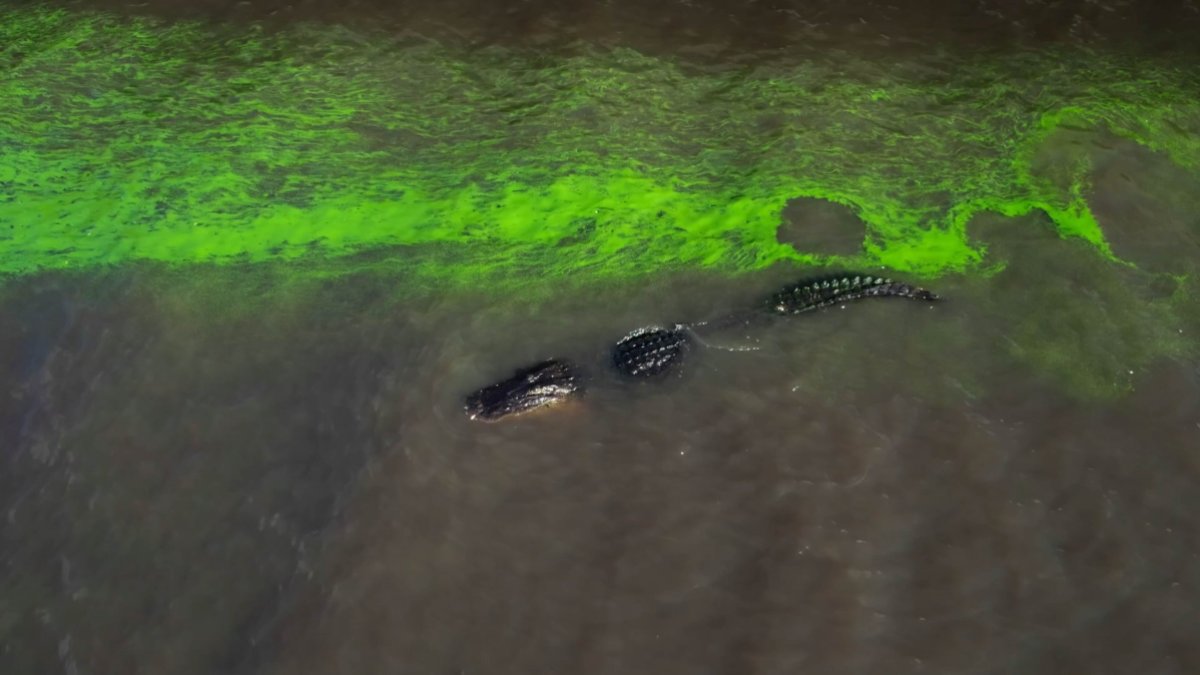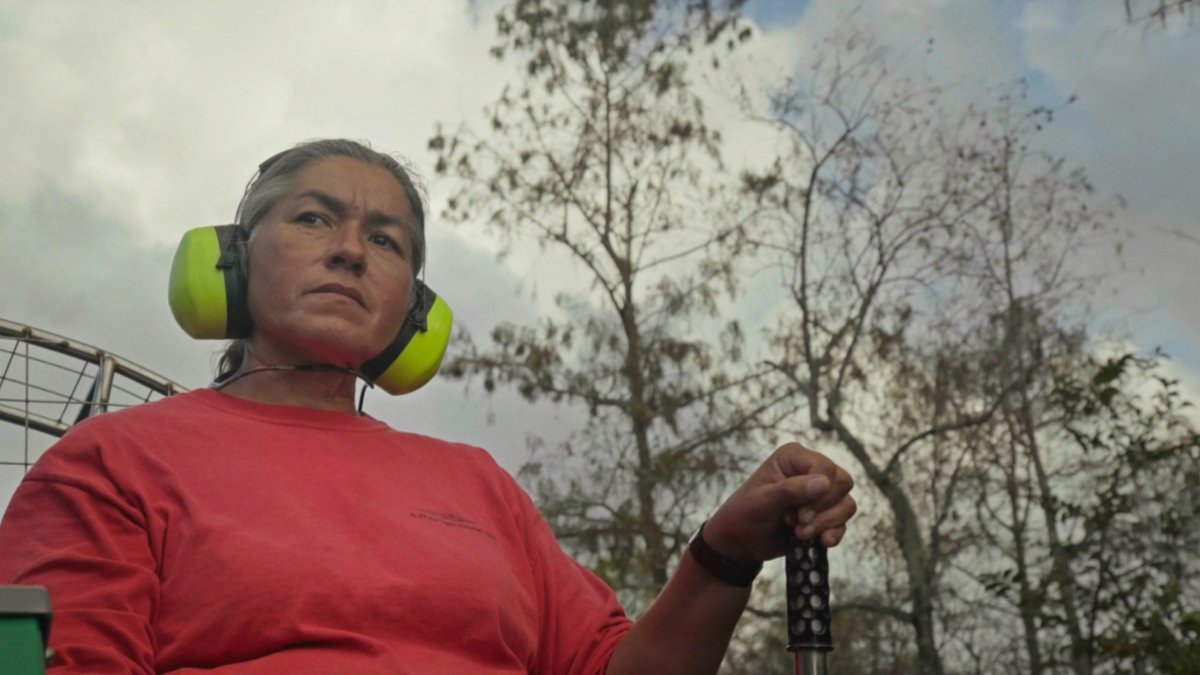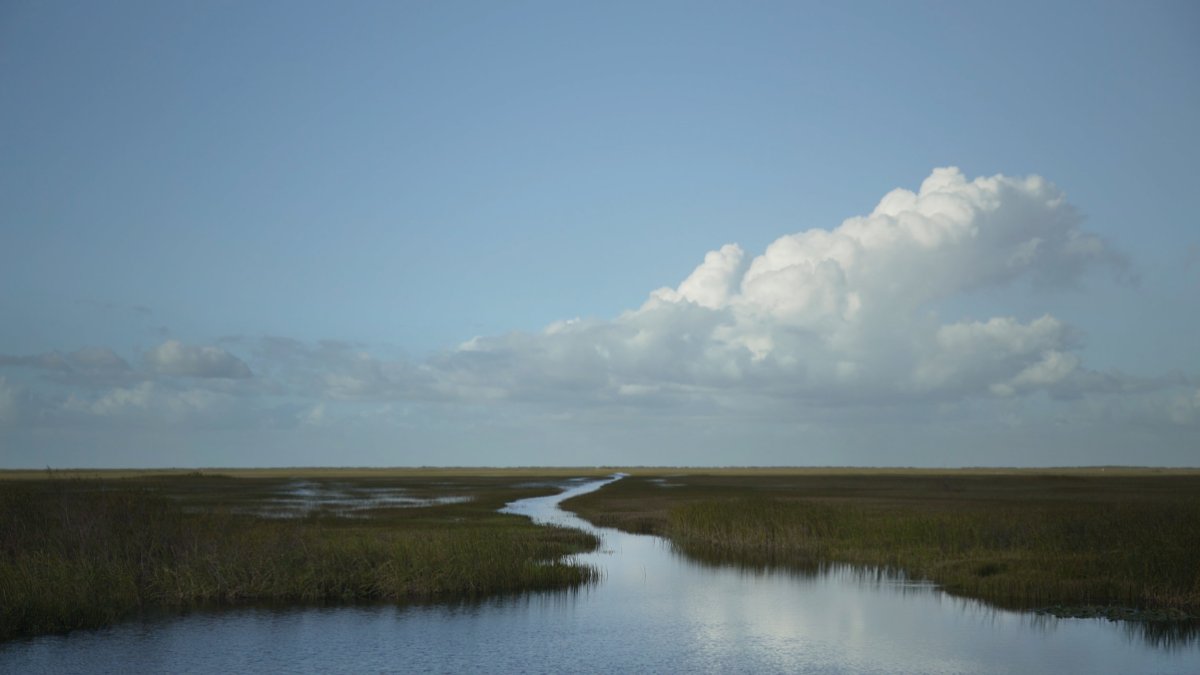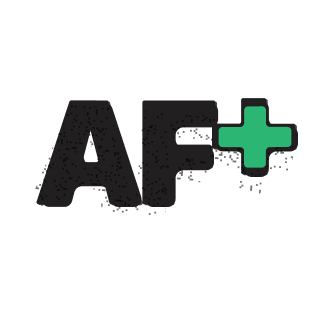For all the jokes about Florida, the people who actually inhabit the state know its beauty. There’s a rich history in this state, not just in the buildings and communities that have been built over decades, but in the stunning natural landscapes that have always been there and, unfortunately, find themselves being regularly exploited and destroyed. To watch Sasha Wortzel’s feature documentary, River of Grass, is to experience a bit of the beauty and pain of existing in Florida surrounded by the Everglades.
Not to be mistaken with Kelly Reichardt’s only Floridian film of the same name, Wortzel’s River of Grass is a necessary document about the Everglades at this point in time anda personal reflection on what it means to connect with other communities for the greater good. By weaving together everything from archival material of the grasslands, Marjory Stoneman Douglas’ seminal text (The Everglades: River of Grass), Indigenous voices and activists Betty Osceola and Reverend Houston R. Cypress, and contemporary verité footage of prayer walks in the Everglades and around Lake Okeechobee, the film becomes a mirror of the vast scale of the Everglades themselves in our lives.
That it serves as a personal memoir, educational text, and call to action all at once is what makes River of Grass feel essential in a time when everything in Florida feels fraught with danger. As a fellow queer Floridian watching the film — as well as Wortzel’s past work like How to Carry Water, This Is Not An Address, and Happy Birthday Marsha (co-directed with Tourmaline) — I couldn’t help but get swept away by it. I found myself thinking a lot about the way so many communities in South Florida intersect and adapt. Coming up just before a screening at Frameline, Sasha and I sat down to talk about the film, the region’s history and politics, and the way queerness and nature intersect.
Juan: I feel like it’s a very Floridian thing to just grow up with the Everglades as something that’s always there, for airboat rides and swamp walks, but not something you’re connected with in any real capacity. What was your experience with it growing up?
Sasha: Like most Floridians, I grew up knowing that the Everglades existed and was there, yet I wasn’t necessarily spending a lot of time in the Everglades. My earliest memories are driving from the West Coast to the East Coast through them and I think that’s a common way that many Floridians experience this vast region of wetlands that our water comes from: as a place to pass through to get from one coast to the other. I think many Floridians also don’t understand what they are, might even find them scary and intimidating. Some people look and say “what’s there?” It seems like nothing’s there and though I did grow up having a pretty strong relationship with the environment – being on the water, being in coastal mangroves, kayaking, and I was like a junior naturalist – but I didn’t understand how my more immediate ecosystem that I grew up in was a part of this larger, vast interconnected system that is the Everglades. That’s something I really had to seek out on my own.
Juan: Yeah, Floridian schools don’t really educate you on this. There’s not enough weight placed on how integral the Everglades is.
Sasha: It was very much a thing of the 90s where our education around the environment was not stressing the interconnectedness of things and simply focused on teaching us to turn off the lights, recycle, and plant a tree on Earth Day. With that, you’ve done your part and we still see that today. The responsibility is often placed on the individual rather than on larger systems or corporations that are actually the culprit in extracting, polluting, and destroying our wetlands and natural wild spaces.
Juan: And I think your film speaks to that by actively involving various communities who are impacted and exist with the Everglades. Not to jump into the political immediacy of it, but I do wonder: do you consider your film something of a call to action, particularly in informing people about how much the Everglades impacts us?
Sasha: I believe my film is an invitation to learn more and to become engaged with the environment and educated in how interconnected everything is. I’m happy if it feels like a call to action too; I think it is in essence, with Betty’s last lines in the film [“Nature will always win in the end. You have to decide if you’re going to be there as a part of that win, and, if you don’t, she’s going to win without you.”] More than anything, I think the experience of making the film, for me, was sort of like getting to know a relative who’s always been there in a much deeper, more intimate, way.

Juan: The film kicks off with you dreaming about Marjory Stoneman Douglas and navigating the impact of hurricanes, so that makes sense. Were those the actual triggers that kicked off the creation of River of Grass?
Sasha: I was thinking about how, in my lifetime, I had seen many of our wetlands and wild spaces fundamentally change or disappear altogether. I was watching more frequent and intense storms and hurricanes, noticing that our water quality was really declining, and that, on both coasts, we were experiencing forms of harmful algal blooms. Red tides and green algae that were sucking the oxygen out of the water, causing these mass fish killings, and giving people health problems. I was feeling overwhelmed by it all, devastated and sad, and then realized that I didn’t quite understand why. I knew that it had something to do with the Everglades’ water system, and that our temperatures (in and out of the water) are rising, but I wanted to unpack that and understand it better for myself in order to process some of my grief and understand my place and what action I could take.
I started by picking up Marjory Stoneman Douglas’ book because, even today, it’s still considered one of the essential resource guides to the Everglades and the first non-fiction study of the Everglades. I’d also applied to Artists in Residence in Everglades (AIRIE) and arrived just after Hurricane Irma – there were tons of trees and phone lines down and the water levels were much higher than usual for that time of year – so, of course, hurricanes were on my mind. I spent that month reading Douglas’ book and using it to create a sort of roadmap of some of the stories, the sites, and the themes I might explore in the film, as well as reaching out to people who were removing pythons or riding around with rangers by boat taking water samples.
I met Houston Cypress at the Marjory Stoneman Douglas Archives while doing some research after having written them prior to coming to the residency, knowing that one could not make a film about the Everglades without engaging Indigenous voices, and it was also at that time that I met Betty Osceola at Buffalo Tiger Air Boats. I was telling her what I was imagining and she said, “Hang on a second,” went and put gasoline in her airboat, and said “get on.” I went on a long ride with her and her late husband Jimmy and we walked and talked about a prayer walk she was organizing to walk the entire circumference of Lake Okeechobee. She invited me to join her, and so I did.
Juan: That is such a massive endeavor, but it sounds magnificent.
Sasha: From there, I just realized that it was going to be a film that reimagines Douglas’ book; her words in it felt very prescient and relevant, and yet it stopped in 1947. So much has followed that up to the present, so I wanted to weave her words alongside these portraits of what’s happening now. And that’s kind of how the project began, but then another hurricane came during the making of this and really destroyed where I’m from. Douglas did come to me in a dream during this time, telling me that she had more to say and felt she’d been forgotten. I felt that she wanted a direct address with the audience, not just through her book, and it launched me into doing more archival research and uncovering interviews with her where I was moved by her presence and bluntness.
She was so direct, so funny, so unapologetic, and a lot of what she said was extremely resonant with what’s happening now. She needed to be part of the story and all these elements needed some kind of grounding and a perspective, some kind of glue, and that had to be me. I realized it was also my story, but Douglas prompted me to pursue this project.
Juan: And you bring up trying to piece it all together, but I’m so interested in how you approached something as grand as the Everglades. There’s science, there’s spirituality, there’s history, there’s politics – obviously you’re grounding it in yourself, but how do you try to parse all of it down into something that isn’t just an info dump?
Sasha: It’s not an easy task and also why this was a project that took many years to make. I naively didn’t realize the education it would require of me; I’d need to learn Indigenous history, hydrology, legal frameworks around the Everglades, there’s just so many layers. Once I started meeting and engaging with people on the ground who call this region home, that would lead me to another story and another. It was through the making of this project that I became connected with the Stop the Burn campaign [which aims to eliminate the practice of pre-harvest sugarcane burning in the Everglades] and learned about that. It really took a lot of time and refining, and it was through the editing process that it became clear what would remain and what might be cast out to create something that could tell a very expansive story but wasn’t bogged down in too much detail. I hope people learn a lot about this place through watching, but I wanted it to feel more like you were sort of flowing with the water, digesting and absorbing and learning along the way.
Juan: That makes a lot of sense in how meditative the doc is. It forces you to become one with the nature of the Everglades. Your last short film, How to Carry Water, also had this vibe that you’re just trying to exist in the same space as your subjects. Do you always try to find that connection with them in some capacity?
Sasha: I tend to work on projects where I’m engaging with places and communities that I’m somehow already embedded in on some level. It’s been really important for me to think about landscape not just as background but as a character and to foreground it and really sit with and film with the same kind of dignity and respect that I give to the people that I film. I spent a lot of time in these different ecosystems that are collectively part of the Everglades with J. Bennett, the director of photography.
A really important part of the process for me is also relationship building. During the making of the film, Betty Osceola walked Lake Okeechobee twice. There were two separate prayer walks and I filmed one of them and went on another from start to finish without my camera. I think it was about 120 miles around the lake, mostly in silence. That sort of intention and process is hopefully embedded in the feeling of the film.

Juan: How much of those prayer walks and that journey is just walking and experiencing nature as opposed to moments where people stop and engage with each other?
Sasha: When you’re walking in pairs in a single file line through the Everglades, you’re meant to be silent and listen and pray, to look and witness the environment and connect with it. There’s a rhythm to these moments where you’re moving through the landscape and looking in a way that I think we often don’t look, especially while you’re on foot because of the pace and scale of things. In breaks, Betty would share a story or some kind of knowledge, ones that have been passed down from her ancestors about the ways the land looked when they were there or specific plants. Sometimes there’s breaks where we’re all just hanging out and laughing, eating snacks and enjoying being out there with each other.
It’s about community building when you’re out there with people from all walks of life. Over the course of filming, I watched the prayer walks really grow. Of course, Lake Okeechobee is a particularly long seven-day walk, so not everyone’s going to be able to participate in the full walk due to its intensity. But something really beautiful that I felt over the course of the film was the number of people participating in these walks, these spiritual actions, and the Everglades growing and finding intersections between these community members. So Donna and her daughter, I’d been out with them removing pythons, and then a few months later, we were on this walk together. It was interesting to see not only the interconnectedness of the different ecosystems that make up the Everglades, but the people themselves, and I wanted the structure of the film to reflect that as well.
One of the teachings that Betty spoke about during the making of the film was this Miccosukee teaching of land as ancestor, with trees and animals that are all our relatives. And in Douglas’ book, she very intentionally uses the pronoun “they” to describe the Everglades – this non-binary, plural pronoun – and I was really moved by these two ideas.
Juan: That makes a lot of sense to me because the film kind of ebbs and flows through all these different facets of community and ecosystem. I actually love that you bring up the non-binary pronoun for the Everglades because I’m wondering: How did your own queerness and your past work that looks at queer bodies in natural (and unnatural) spaces influence this film?
Sasha: I mean, how could it not? It’s just one of the lenses through which I experience and engage with the world, and the idea of the collective, the “they”, this sort of expansiveness of gender and community with plants, animals, and the unknown, like our ancestors and spirits. I think there are moments that do feel more explicitly queer in the film, like Houston walking through this beautiful cypress dome and saying that chosen family is a survival strategy.
Even something like Marjory being asked by a journalist why she never remarried. Would a journalist ever ask a man that? Of course not. I was moved by her answer being that she couldn’t be bothered with a man and was busy. Marjory may not have been queer, yet the way she lived her life defied a lot of prescribed gender roles. She did not marry, she did not have kids, and she wasn’t focused on this nuclear family unit because her family was the Everglades, her friends, her writing, and her art, the things she devoted her time to.
Something that really informed my approach to this project and How to Carry Water was thinking about the way in which queer bodies and trans bodies, like the wetlands, defy or refuse tidy binary categories. Wetlands are both land and water; the Everglades are sometimes dry as a bone and you can walk across and, other times, it’s flooded. It’s not any one thing, and there’s an interesting connection too in the way that wetlands have been demonized, extracted, drained, and reengineered that mirrors what we see happening in dominant culture with violent transphobic narratives.
Juan: So many people outside of these lived experiences and natural bodies are trying to force their will onto them, but you can’t change or stop what exists.
Sasha: Yeah, I think the same violent forces that deem a trans body, or a disabled body, or a fat body, unworthy or disposable in this world are the same forces that deem a swamp as unworthy or something we don’t need. And that is intimately connected to all kinds of violence and settler colonialism here in the United States and with what we’re seeing happening abroad.
Juan: And your film is explicitly in conversation with the fact that the world is comfortable destroying these things. Obviously your work is political – even thinking back to something like This is an Address, which features Sylvia Rivera – because you can’t make work like this without it being political, but what do you hope for with a film like River of Grass? Are you hoping for it to spark conversations about gentrification or destruction or faulty politics in Florida that make nothing last here?
Sasha: That’s the very story of Florida: Build as fast as you can before things sink or build and make as much money as you can before the next hurricane.
Juan: Does it feel like you ended up capturing the Everglades before it’s too late?
Sasha: There is an awareness that I am trying to tell a story that covers such a wide span of time and that connects the past to the present. To make this film is to create a document of a specific time and place because the way things look and feel are constantly changing. I hope the film is an invitation to become more connected to our environment and to each other, to our larger collective movements. Something that’s important to me with this film – that’s maybe not said explicitly but hopefully embedded in the architecture – is that climate justice is very intersectional. It cuts across race, class, gender, and sexuality, and connects to everything. Finding these interconnections between our movements and coalition building is really the way forward.
We are stronger together when we are thinking about how we can all get free and how our liberation is connected to our neighbors. We also need to listen to and support Indigenous voices and center those who are most impacted in our movements. Those are the experts and recognizing and dismantling these ongoing legacies of settler colonialism is central to the environmental justice movement. Those are some of the many things I’ve learned and taken away from the process of making this film. I started in this place of devastation and grief, feeling overwhelmed and unsure of what to do, and now I have all these answers and solutions. Through the making of the film, through learning our history and who came before, and by connecting with a broader coalition of neighbors in the region, I now feel more hope.




love this so much
“I hope people learn a lot about this place through watching, but I wanted it to feel more like you were sort of flowing with the water, digesting and absorbing and learning along the way.”
I’m definitely going to watch this film now. I love the Everglades.